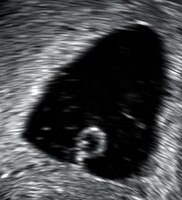
Photo from wikipedia
Background Fetoplacental discrepancies occur in approximately 1–2% of analyzed prenatal cases. They are typically due to confined placental mosaicism, where an aberration is observed in the placental cells but not… Click to show full abstract
Background Fetoplacental discrepancies occur in approximately 1–2% of analyzed prenatal cases. They are typically due to confined placental mosaicism, where an aberration is observed in the placental cells but not found in the fetal cells. Confined placental mosaicism usually involves aneuploidies and more sparsely structural chromosomal aberrations. To the best of our knowledge, this is the first reported case of a discrepancy in the analyses of chorionic villus sampling and amniocentesis involving two different structural chromosomal aberrations of chromosome 21. Case presentation We report a 33-year-old woman who was referred for a non-invasive prenatal testing due to an increased risk of trisomy 21 gleaned from a combined ultrasound and blood test. The non-invasive prenatal testing showed an increased risk of trisomy 21 with a normalized coverage signal that did not match the fetal cell-free DNA fraction. Rapid aneuploidy detection performed on uncultured chorionic villi indicated mosaicism for trisomy 21. The follow-up analyses revealed discordant chromosomal aberrations: 46,XY,der(21)t(10;21)(p11.21;q10) in the analysis of the chorionic villus sampling and 46,XY, + 21,der(21;21)(q10;q10) in the analysis of the amniocentesis. Thus, the analyses indicated mosaicism for a cell line containing trisomy 21 and a cell line containing a partially duplicated short arm of chromosome 10 in the chorionic villi and complete trisomy 21 resulting from an isochromosome 21 in the amniotic fluid. The analyses of the lymphocytes and the fibroblasts of the woman were normal. Conclusions We propose a multiple-step mechanism as a possible theoretical explanation for the formation of these discordant structural chromosomal aberrations in the chorionic villi and amniotic fluid. With this case report, we want to highlight the importance of understanding the possible underlying embryological mechanisms when interpreting results from different prenatal analyses.
Journal Title: Molecular Cytogenetics
Year Published: 2021
Link to full text (if available)
Share on Social Media: Sign Up to like & get
recommendations!